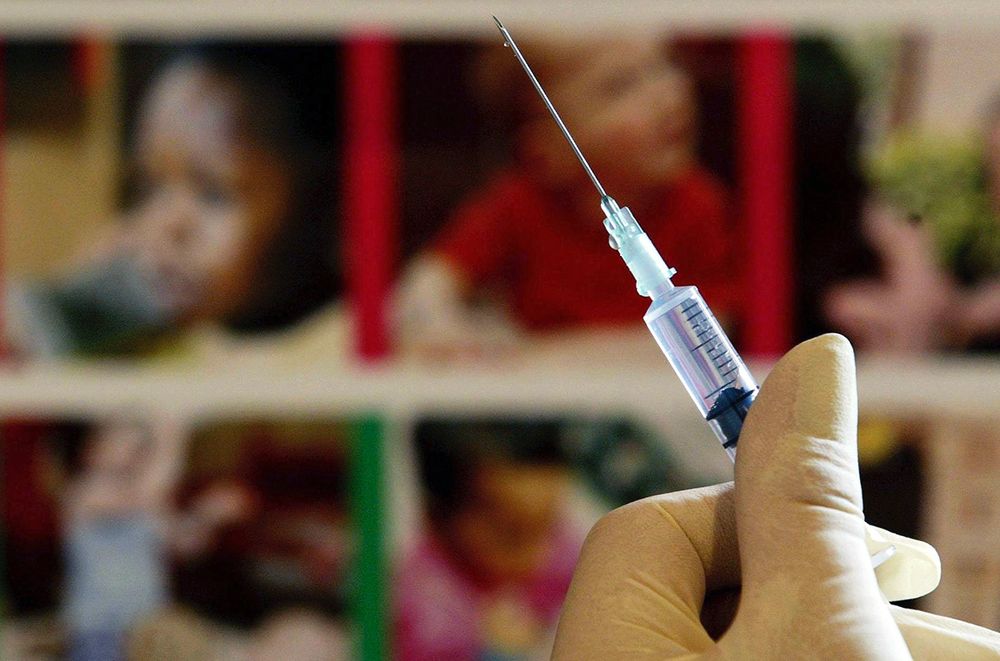
Due to maintenance, Research.gov (including access to NSF-PAR, GRFP, PES, and ETAP) will be unavailable from Fri., 4/25 at 10:00 PM ET to Sat., 4/26 at 1:00 PM ET. NSF apologizes for any inconvenience.
🚨 Practical URGENT tip for NSF grantees:
Out of an abundance of caution, I would right now go into Research.gov and…
1. Download your NSF award letters.
2. Print PDF your annual reports.
3. Screenshot the status table for annual reports.
NSF is planning maintenance tomorrow to Research.gov
24.04.2025 21:32 — 👍 661 🔁 510 💬 8 📌 25

a cartoon of a man holding a frying pan and a spoon with red alert written above him
ALT: a cartoon of a man holding a frying pan and a spoon with red alert written above him
ATTENTION: NSF GRANT RECIPIENTS
We received a heads up from a trusted source that you should proactively download/print/screen shot any documentation on research.gov pertaining to your NSF awards, both those that are current and any that have closed in the last 5-6 years.
1/n
24.04.2025 21:09 — 👍 1046 🔁 923 💬 25 📌 43

From the Community | Is it 1984 in 2025?
Stanford’s leadership must join with other universities to stand up and fight for American higher education, write Professors Riskin and Satia.
"The silence from the leaders of our university—at least in public—suggests the assault has already produced the intended chilling effect, but together we can overcome it." Good read from Stanford History profs Jessica Riskin and Priya Satia.
stanforddaily.com/2025/03/17/i...
31.03.2025 17:29 — 👍 2 🔁 0 💬 0 📌 0

Variability of mutational signatures is a footprint of carcinogens
Understanding the genomic impact of carcinogens is fundamental to cancer biology and prevention. However, recent coordinated efforts to detect such fingerprints have been largely unsuccessful, challen...
Thanks! Totally! We have a preprint using a similar framework to look at mutational signature heterogeneity across tumors (collab with @nalcala.bsky.social doi.org/10.1101/2023...) and we also used this framework to look at heterogeneity of immune cell infiltration (analysis not published yet).
17.03.2025 18:59 — 👍 0 🔁 0 💬 0 📌 0
#mevosky #microsky
14.03.2025 20:51 — 👍 2 🔁 0 💬 0 📌 0
PNAS
Proceedings of the National Academy of Sciences (PNAS), a peer reviewed journal of the National Academy of Sciences (NAS) - an authoritative source of high-impact, original research that broadly spans...
8/8 FAVA is the culmination of many conversations and collaborations. Thanks especially to my co-authors, @ksxue.bsky.social and Noah Rosenberg–I truly feel like I won the collaborator/mentor lottery. And thanks to you for reading! Paper is here if you want to read more: doi.org/10.1073/pnas...
14.03.2025 20:46 — 👍 7 🔁 0 💬 3 📌 0
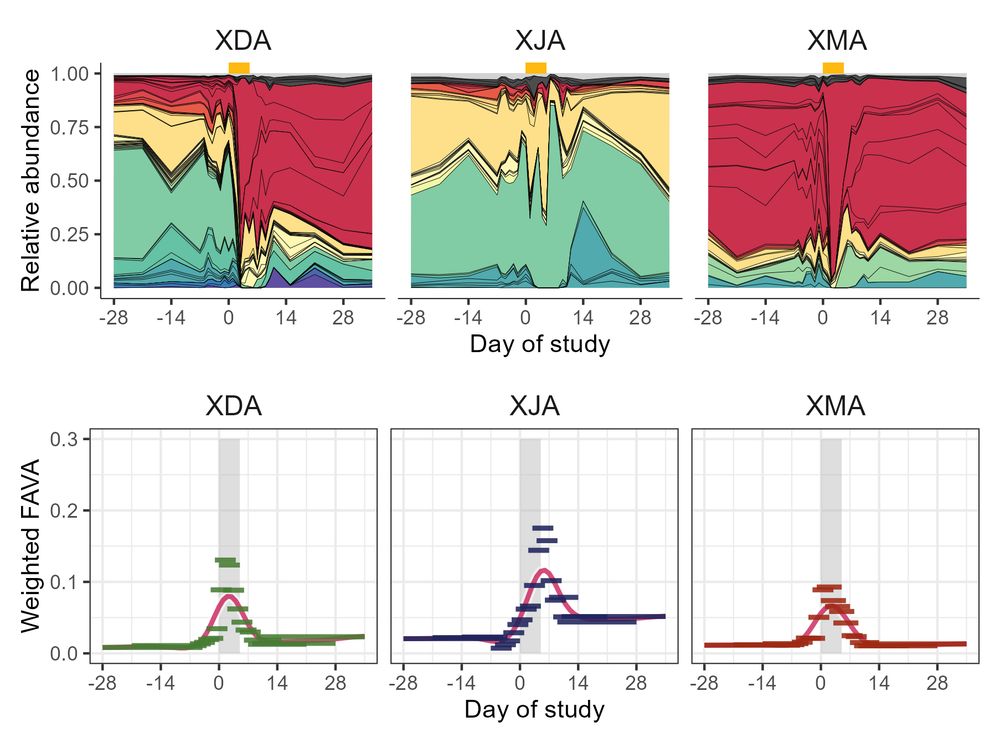
Plot showing longitudinal microbiome composition for three individuals who took an antibiotic, along with corresponding plots showing FAVA computed in sliding windows. For all subjects, FAVA increases during the antibiotic window. In one subject (XDA) we see that FAVA can return to stability (low FAVA) without returning to the pre-abx composition.
7/ (Ex. 2) In longitudinal microbiome samples from healthy humans taking an antibiotic (collab with @ksxue.bsky.social), FAVA is much higher post-abx than pre-abx, and just half of the 22 subjects return to their baseline FAVA level (computed in 6-sample sliding window) during the 30 days post-abx!
14.03.2025 20:46 — 👍 5 🔁 0 💬 1 📌 0
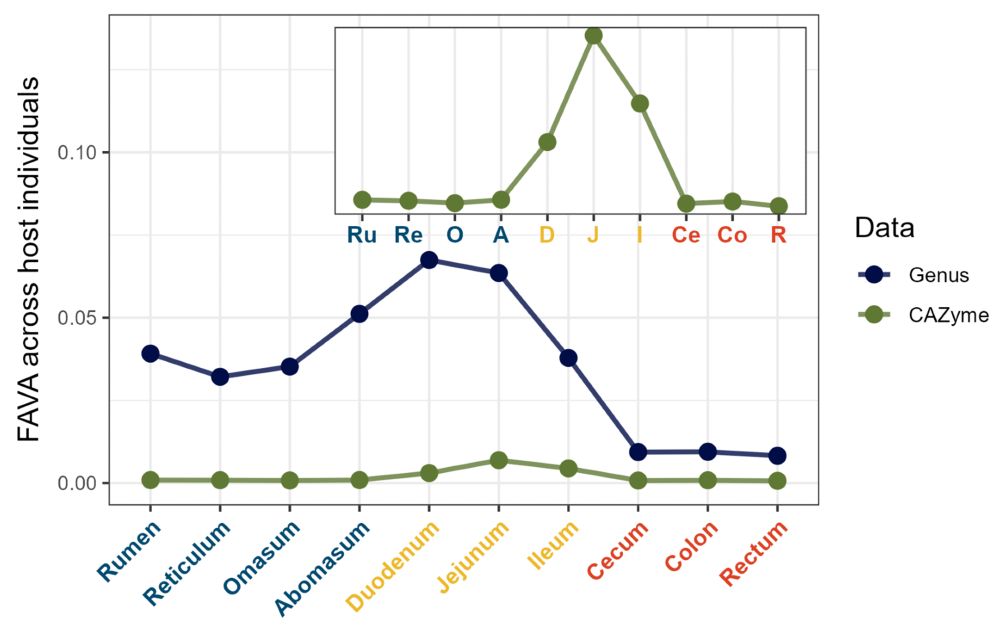
Plot showing FAVA computed with genus or CAZYme abundances across ruminant host individuals. FAVA is much higher for genus than CAZyme abundances. For both data types, FAVA peaks in the small intestine and is quite low in the large intestine, suggesting much variation across individuals would be missed with stool sampling.
6/ (Ex. 1) In microbiome samples collected along the GI tracts of individuals from 7 ruminant species, FAVA peaks in the small intestine–so lots of variability would have been missed by stool sampling! We also find taxonomic variability >> functional variability–evidence for functional redundancy.
14.03.2025 20:46 — 👍 5 🔁 0 💬 1 📌 0
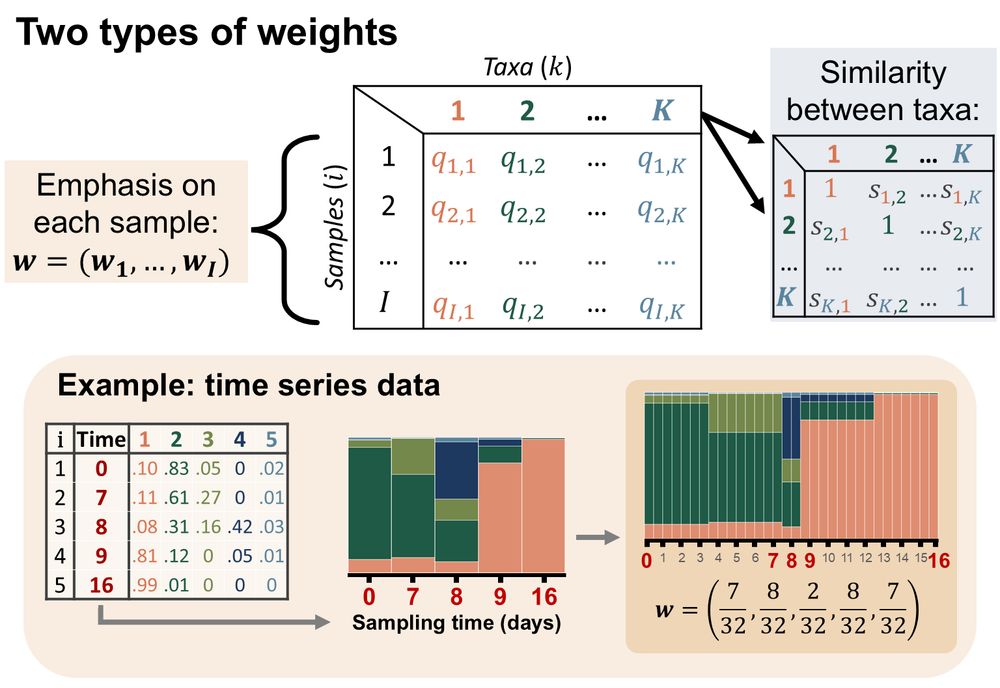
Diagram showing that FAVA can incorporate a matrix giving the similarity between each pair of taxa, as well as a vector of weights for each sample, which can be particularly useful for time series data with uneven sampling times.
5/ FAVA can account for phylogenetic similarity among taxa and can differentially weight samples, which is especially useful for time series data (Fig. 3). FAVA can be computed in sliding windows to see how variability changes over space or time (Fig. 4). We demonstrate FAVA in 2 examples.
14.03.2025 20:46 — 👍 5 🔁 0 💬 2 📌 0
4/ FAVA can analyze any relative abundance data, including taxonomic categories like OTUs and species, and functional categories like CAZymes and COGs. You can directly compare FAVA values computed on data with different numbers of categories (e.g., variability of bacterial species vs. families).
14.03.2025 20:46 — 👍 3 🔁 0 💬 1 📌 0
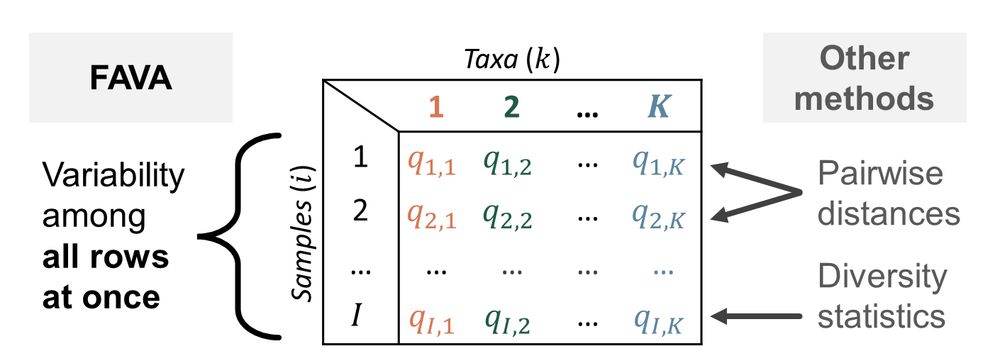
Schematic showing that FAVA measures variability across all rows of an OTU table at once, while other methods measure the diversity of one sample or the distance between a pair of samples.
3/ FAVA extends the pop-gen statistic FST (which traditionally measures variability of allele frequencies across multiple populations) to instead measure variability of taxonomic or functional abundances across multiple microbiome samples (Fig. 1). All it needs is an OTU table, or similar.
14.03.2025 20:46 — 👍 6 🔁 2 💬 1 📌 0
Analysis of microbiome data with FAVA
2/ FAVA is implemented in an R package available for download from CRAN (just run install.packages("FAVA") in R). For detailed guidance on the analysis of microbiome data with FAVA, check out the tutorial on the package website: maikemorrison.github.io/FAVA/article...
14.03.2025 20:46 — 👍 6 🔁 0 💬 1 📌 0

5 relative abundance plots arranged to have increasing compositional variability (variability across relative abundance samples, here vertical bars)
1/ Hey y'all, I'm excited to share my latest paper, which is out now in PNAS! We introduce FAVA, a statistical framework to measure compositional variability across microbiome samples. If you want to measure variability across a stacked bar plot, FAVA is for you! Paper: doi.org/10.1073/pnas...
14.03.2025 20:46 — 👍 207 🔁 73 💬 5 📌 2
6/ (Ex. 1) In microbiome samples collected along the GI tracts of individuals from 7 ruminant species, FAVA peaks in the small intestine–so lots of variation would have been missed by stool sampling! We also find taxonomic variability >> functional variability, evidence for functional redundancy!
14.03.2025 19:58 — 👍 0 🔁 0 💬 0 📌 0
5/ FAVA can account for phylogenetic similarity among taxa and can differentially weight samples, which is especially useful for time-series data (Fig. 3). FAVA can be computed in sliding windows to see how variability changes over space or time (Fig. 4). We demonstrate FAVA in 2 examples:
14.03.2025 19:58 — 👍 0 🔁 0 💬 1 📌 0
4/ FAVA can analyze any relative abundance data, including taxonomic categories like OTUs and species, and functional categories like CAZymes and COGs. You can directly compare FAVA values computed on data with different numbers of categories (e.g., variability of bacterial species vs. families).
14.03.2025 19:58 — 👍 0 🔁 0 💬 1 📌 0
3/ FAVA extends the pop-gen statistic FST (which traditionally measures variability of allele frequencies across multiple populations) to instead measure variability of taxonomic or functional abundances across multiple microbiome samples (Fig. 1). All it needs is an OTU table, or similar.
14.03.2025 19:58 — 👍 0 🔁 0 💬 1 📌 0
I've been tremendously fortunate to work with @ksxue.bsky.social during her time as a postdoc at Stanford. She's not only a brilliant scientist and an excellent mentor/collaborator, but also a wonderful human being. You should totally join her lab!
14.03.2025 00:28 — 👍 6 🔁 0 💬 0 📌 0
PNAS
Proceedings of the National Academy of Sciences (PNAS), a peer reviewed journal of the National Academy of Sciences (NAS) - an authoritative source of high-impact, original research that broadly spans...
I’m thrilled to share my first ever publication, now published in PNAS! www.pnas.org/doi/10.1073/...
With mentorship from the amazing @ksxue.bsky.social, I looked at how the outcomes of species introductions to microbial communities are influenced by the number of introduced microbes.
11.03.2025 13:22 — 👍 89 🔁 31 💬 1 📌 1
Reading "The Science Bargain" by Rush Holt: "Democracy is at risk when it becomes simply a contest of opinions not grounded in evidence. When one opinion is as good as another–each asserted as strongly or even as deceptively as possible–democracy cannot survive. This is a call to science."
12.03.2025 14:07 — 👍 0 🔁 0 💬 0 📌 0

Maike holding a sign in front of SF city hall. Sign is a parody of the Gadsden flag. Text on bottom says, "don't tread on me." Snake usually on Gadsden flag is replaced with a caterpillar phylogenetic tree.

Large crowd in front of SF city hall.
It's been easy to feel powerless these past few months, but the @standupforscience.bsky.social rally in SF this afternoon was an important reminder that the fight is not over!
08.03.2025 01:59 — 👍 7 🔁 0 💬 1 📌 0
Today's small joy was discovering the latex package "etaremune," which you can use in place of "enumerate" to count in reverse
23.07.2024 21:54 — 👍 3 🔁 0 💬 0 📌 0

Beach with palm trees and a sailboat
I'm stoked to be at #SMBE2024! If you're interested in variability/diversity, microbiomes, and/or non-traditional applications of FST, I would love to chat!
Poster Weds #44, title: Quantifying the stability of microbiomes and the timescale of antibiotic perturbation with FAVA
09.07.2024 04:37 — 👍 4 🔁 0 💬 0 📌 0

A sheet of colorful stamps titled "life magnified." Stamps include a moth antenna, mold spores, barnacle legs, and diatoms arranged like a snowflake.
Just bought some science stamps! Now we only need a theory edition... store.usps.com/store/produc...
09.02.2024 16:16 — 👍 1 🔁 0 💬 0 📌 0
I think this is something I asked students about when I was interviewing for grad programs? I know expectations about conference travel can vary a lot between labs and institutions.
07.02.2024 06:46 — 👍 1 🔁 0 💬 0 📌 0
I've been really fortunate to have a great PI and have been able to go to whatever conferences we decide make sense for me to attend.
06.02.2024 23:34 — 👍 1 🔁 0 💬 1 📌 0
I can't believe we didn't put TAGC on this list, a bunch of us are going this year!! 🤦♀️ Thanks for adding!
05.02.2024 21:27 — 👍 0 🔁 0 💬 1 📌 0
Summer Schools:
CGSI - computationalgenomics.bioinformatics.ucla.edu
Santa Fe Institute Complex Systems Summer School - www.santafe.edu/engage/learn...
05.02.2024 17:43 — 👍 0 🔁 0 💬 1 📌 0
US NSF postdoc at the Monterey Bay Aquarium Research Institute
Incoming Group Leader at University of Zurich (www.woestreich.com)
I explore the ecology of collective behavior in dynamic ecosystems.
Posts about ecology, evolution, waves, music, etc.
Mathematics & Evolution!
Ph.D. at University of Toronto (EEB Dept)
Alumnus IISER Mohali. He/him
Omidyar Postdoctoral Fellow at the Santa Fe Institute, interested in major evolutionary transitions, cooperation, conformity, and AI. Canadian 🇨🇦 she/her
Ecology and Biocomplexity
PhD candidate with Molly Schumer studying adaptive trait evolution
Loves all sparkly things, especially swordtail fish! 🐟✨
Postdoctoral Researcher
@Lawrence Livermore National Lab
Interested in:
plant - microbe interactions | microbe - microbe interactions | community ecology
🧫 🌱 🏔 🌊
fungi-aware 🍄⎜mother⎜ she/her 🌈
https://sites.google.com/view/jessica-bernardin
genomics @ stanford
gpreising.github.io
he/him
Incoming postdoc at Genentech | PhD from Stanford Biomedical Data Science.
Complex traits, gene regulation, ELSI (ethical, legal, and social implications of) genetics
PhD candidate with the Pritchard Lab @Stanford
Computational evolutionary biologist. Associate Professor at @sandiegostate.bsky.social, athlete, insomniac, writer, singer, polyglot, polymath. He/him. 🏳️🌈🇮🇳🇺🇸🐞🌱🐢🧬🏋🏾♂️🎤✍🏾 www.sethuramanlab.com Views are mine and mine alone.
PhD candidate in the Edge Lab @USC. Working at the intersection of population genetics and forensic genetics. 🇹🇳
contributing editor, Scientific American, Nautilus; contributing writer, Quanta; author, Putting Ourselves Back in the Equation, Spooky Action at a Distance, Complete Idiot’s Guide to String Theory; planetary scientist, local historian, bassist, salsero
Menswear writer. Editor at Put This On. Words at The New York Times, The Washington Post, The Financial Times, Esquire, and Mr. Porter.
If you have a style question, search:
https://dieworkwear.com/ | https://putthison.com/start-here/
Professor @Stanford
Epidemiology, Genetics, & Data Science
Stanford Cancer Institute
++ data, colleagues, family & friends
Bachelor's @duke-university.bsky.social | PhD candidate
@stanford.edu studying evolutionary biology for conservation genomics| NSF GRFP Fellow | CMB Training Grant | DARE Fellow| just tryna save the animals #BlackLivesMatter
NSF Postdoc Fellow with U of Michigan | PhD from UF I polyploidy evolution + Botany | https://mlgaynor.com/
Ph.D. candidate at Edge Lab @USC | dancer. Stat & pop gen, with some anthropology hopefully. Meet my Chinese name 刘君健 (Liu Junjian)
PhD student in evolutionary biology @UChicago
Spatial & temporal structure of biodiversity and morpho complexity; evolution and genetics of complex traits
Postdoc @uwgenome 🐶
PhD Genetics @uarizona 🐱
BA Chemistry @brynmawrcollege 🦉
Population Genomics, Machine Learning, Cancer Evolution 🧬💻
📍Seattle, WA & Vancouver, BC
https://www.linkedin.com/in/linhnhtran/










